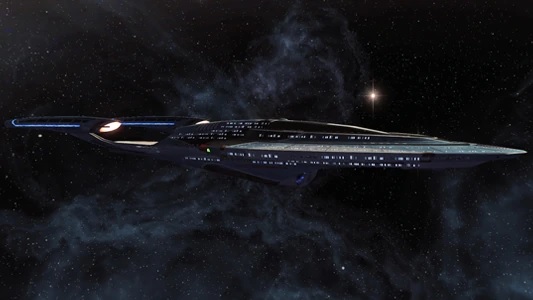Vesta Class
Created by Fleet Admiral Luzol Targaryen on Mon Jul 17th, 2023 @ 11:25pm
Vesta Class
 | |
| Affiliation: | Federation Starfleet |
| Service Period: | 24th - 25th Centuries |
| Length: | 672 meters |
| Width: | 195 meters |
| Height: | 88 meters |
| Mass: | 3,321,630 metric tons |
| Decks: | 23 |
| Crew: | 750 personnel |
| Speed: | Warp 9.99 Quantum Slipstream |
| Armament: | Phaser Arrays Phaser Cannons Torpedo Launchers |
| Defenses: | Regenerative Shielding |
| Auxiliary craft: | Starfleet Runabout Starfleet Shuttlecraft |
Overview
In 2376 the Pathfinder Project, a Starfleet Communications Team assigned to establish contact with the lost Starship Voyager, was able to successfully raise the ship. Soon after, Pathfinder was able to setup monthly data streams that allowed two way communication between Voyager and Starfleet. As part of the transmissions, Voyager was able to share detailed technical schematics of the Quantum Slipstream Drive developed by Delta Quadrant Species 116 as well as the details of the U.S.S. Dauntless, a facsimile of a Starfleet vessel used to dupe the crew of Voyager with the intent of sacrificing them to the Borg Collective.
While many of the Voyager technologies were immediately classified by the Federation Department of Temporal Investigations, the Federation Science Council was eager to reestablish an exploratory presence in the galaxy and coordinated the release of the Quantum Slipstream schematics. The Corps of Engineers began efforts to replicate the Dauntless Class in fulfillment of the new protocols of building smaller, specialized vehicles; nonetheless, Starfleet Command was focused on constructing a new capital ship to incorporate the Quantum Slipstream technology. With the return of Voyager in 2378 and direct access to a Quantum Slipstream Drive for the first time, their desires were only strengthened. Through special authorization of the Office of the Federation President, Starfleet Command commissioned development of the Vesta Class, Starfleet's first original Quantum Slipstream powered vessel.
B'Elanna Torres, former Chief Engineer of the Starship Voyager and Starfleet's leading expert on Slipstream Technology, oversaw development of both the Vesta and Dauntless following Voyager's safe return. Construction of the first generation Vesta Class starships would begin at Utopia Planitia Fleet Yards, Mars in 2380; however, production would be stalled by the First Contact Day Massacre in 2385. Through the usage of the Mars Defense Perimeter and modified vessels, the Utopia Planitia Ship Yards, orbital facilities, and Mars itself were devastated with 92,143 killed. With all under construction vessels destroyed in the attack Starfleet Command postponed further construction of the Vesta Class.
Capabilities
One of the largest ship designs of its era, the Vesta Class has a unibody construction that successfully merges its ovoid-shaped primary hull and its cylindrical engineering hull. A large Shuttlebay and Flight Deck were included in the design to allow the Vesta access to a variety of support ships during her missions of exploration outside of Federation territory. 20 Transporter Units have been fitted into the design for the usage of the vessel's 750 crewmembers and the ship can transport up to 24,000 metric tons of cargo for use on its missions of exploration.
The quintessential component of the Vesta Class is the Quantum Slipstream Drive, which allows a starship to travel at speeds exceeding that of a conventional warp drive. Similar in many ways to Transwarp Drive utilized by the Borg, the Quantum Slipstream Drive redirects energy from the Quantum Drive to the Main Deflector, creating a slipstream tunnel that the ship can use to travel at speeds nearing 300 light-years an hour. While many safeguards exist to protect the Vesta while using Slipstream, the longer that the vessel is using its slipstream drive the more instabilities are generated that cause strain to the outer hull, running the risk of a catastrophic collapse that will destroy the ship. To combat the threat to the ship and crew, safety protocols dictate that the Vesta cannot maintain slipstream velocities in excess of three hours.
Utilized for testing of new and experimental technologies, many of the systems being used aboard the Vesta are highly classified with only the highest ranking members of Starfleet having knowledge of their employment. Sensors aboard the Vesta are highly advanced and include multidimensional wave-function analysis modules, which allow the Vesta to detect inter-dimensional rifts, subspace and temporal distortions up to 23 light-years away. A Quantum Field Focus Controller allows the Vesta to maintain communication while traveling at Slipstream velocities, while a Chroniton Integrator allows sensor readings to be taken from several seconds into the future while traveling at slipstream. A Sympathetic Fermion Transceiver strengthens the integrity of the Slipstream Conduit when it action. In deference to its cutting edge nature, the Vesta has a weaker hull strength than its contemporaries but compensates by employing regenerative shielding to protect itself.
Refits and Variants
Highly advanced, few plans exist to refit the Vesta Class aside from enhancements to the Vesta's computer hardware.
Mission Profiles
Multirole Explorer, Strategic and Diplomatic Operations, Technical Testbed. Vessels of the Vesta Class have been designed to perform equally well in both combat and exploration missions. While the Vesta is highly advanced and a frontline exploration vessel, due to the classified nature of the class and its rarity the ship is nearly mythical within Starfleet.
Naming Conventions
Aside from the Vesta herself, ships of the Vesta Class are named for the seven hills of Rome.
Notable Starships
U.S.S. Vesta, Class Prototype U.S.S. Aventine U.S.S. Caelian U.S.S. Capitoline U.S.S. Esquiline U.S.S. Palatine U.S.S. Quirinal U.S.S. ViminalCategories: No categories found